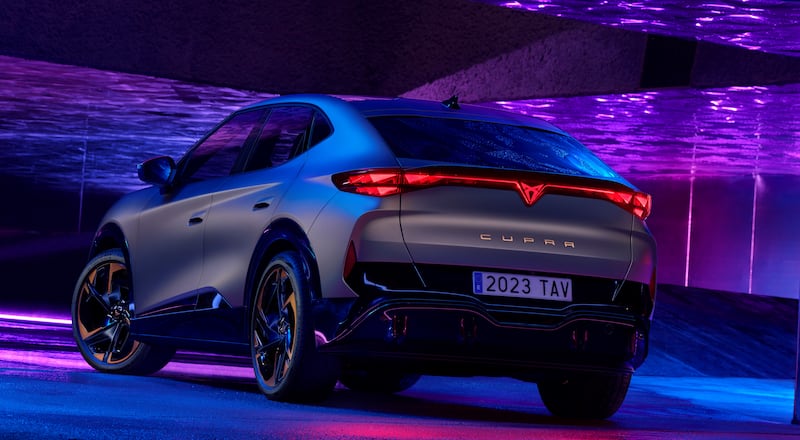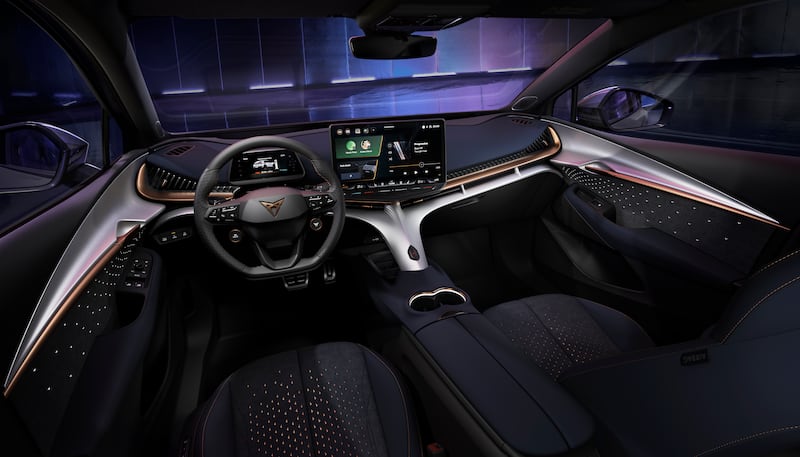If there were any doubts about the direction of travel at the Spanish arm of VW Group, then this new Tavascan crossover SUV should put them to rest. For the Barcelona-based division, Cupra is brand name for the future while Seat’s future remains a question mark.
What began as a high-performance quasi-premium spin-off from the Seat brand has not only overtaken its parent but is now lapping it. First, we had the Born, a very smartly dressed and designed take on the VW ID.3. Now we have Cupra’s version of the ID.4/ID.5 and, as with the Born, the result is a more sharply styled and arguably better-finished alternative to its German counterpart.
True, it’s not quite as striking or sleek as the concept first shown in 2019 at the Frankfurt motor show (remember them?), but it’s close to it in all other aspects.
In profile it’s not quite the coupe we had hoped – more of a beefy big hatch. Up front is a really striking front nose, one of the best-looking iterations on an EV to date, given the struggles designers are having with this part of new cars. Dodging the big grille faux pax or the slab of bodywork mistake isn’t easy.
READ MORE
Seat design director Jorge Diez told The Irish Times about the efforts made to give the car a racing helmet styling with the glass seemingly replicating a wraparound visor. The result has worked, though you can spot elements of the A-pillar at upper front of the side windows.

The high roofline to give rear passengers decent headroom means that the back of the car seems squatter than a sloping coupe, but that’s in keeping with a chunkier crossover look. Yet don’t be mistaken – this car isn’t small.
The images don’t quite do it justice, however, for this is a big car, measuring in at 4.6 metres long.
That’s unsurprising, given it runs on the same MEB platform as the VW ID.4, Skoda Enyaq and Audi Q4 e-tron. Despite the multiple shared elements – both in your eye line and under your feet – Cupra is confident that it’s not simply cannibalising sales from its sister brands.
According to Wayne Griffiths, chief executive of Seat and Cupra, the firm’s research shows that 70 per cent of the brand’s sales go to customers who would not have bought another VW brand. “That means it’s a conquest not just for Cupra but also for the group.”
As to the difference between Cupra and Seat, Griffiths defines Cupra as a brand for car lovers, while Seat is about future mobility. The vagueness of that statement reflects the lack of any publicly stated plan for Seat across the group.
For now, the big news is that Cupra is now the brand with the best-looking mid-range EVs in the VW Group car park.

It even offers up a rival to the much-lauded Audi interior, though it still inherits the annoying swipe bars from VW. The most eye-catching element inside is the reptilian spine that runs between the driver and passenger before sweeping across the dash. Now that’s not something you’ll find in an Audi at present. Dominating the dash is the large 15-inch touchscreen, but, as with the Skoda Enyaq, it doesn’t quite make up for the much smaller screen in front of the driver that’s little bigger than your average mobile phone.
Cupra is making a big play on two design notes: triangles and copper. The former shows up in multiple areas of the car, from the light clusters to the dash, while the colour – not the metal – features as the go-to second colour on the designer’s colour palate.
As with the ID.4, power comes from two options – either a 210kW or 250kW, the latter coming with dual-motor all-wheel drive. This version also provides a claimed range of 550km, courtesy of that version’s 77kW battery pack. A lower-powered 140kW version using VW Group’s smaller battery pack with a net capacity of 58kW is likely to join the range.
Options in the higher grades include variable dampers and the group’s progressive steering system, while brakes will be a mix of discs up front and drums on the rear.
Though designed at the Cupra/Seat home in Spain, Tavascans will be built in the firm’s new production plant in China as capacity in VW’s current European plants are limited.
Arriving next year, Cupra hopes to sell 50,000 Tavascans annually, and this crossover will be quickly followed by the full-sized Terramar SUV, also in 2024, and its funky little all-electric city car offering, the UrbanRebel, due on the road in 2025. As yet pricing for the Tavascan is not confirmed, but our best guess would be north of €40,000 when the full range of power options are on sale – or more given the ongoing inflationary pressures in the new car market.












